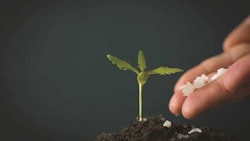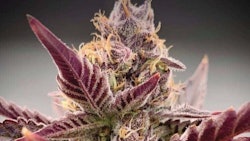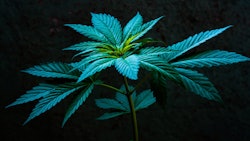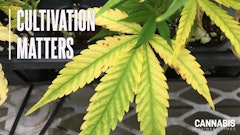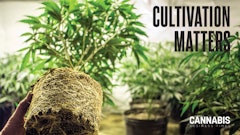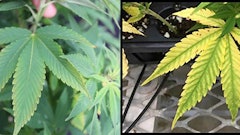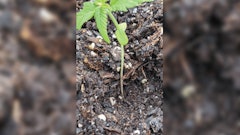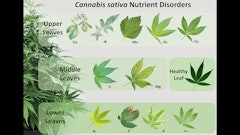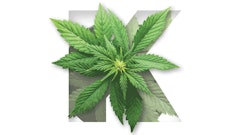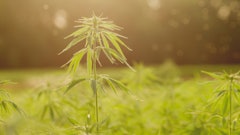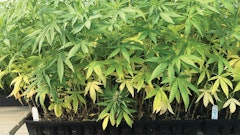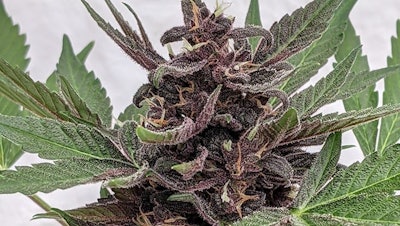

Most cannabis cultivars used in greenhouse production are photoperiodic strains that are primarily Cannabis sativa or C. indica types. These plants require a bulk-up period in production utilizing long days of more than 16 hours of lighting (commonly referred to as the “vegetative period”) to build the framework of the plant before they are induced to flower with longer nights (typically 12 hours).
Autoflowering cannabis varieties derive a portion of their genetics from Cannabis ruderalis and offer the ease of cultivation without having to manage the photoperiodic requirements for flowering (Fig. 1, left). This makes autoflowering varieties popular with some commercial greenhouses and many hobbyist growers.
Growing autoflowering species requires cultivators to modify production protocols. The flexibility of the typical bulking-up period with C. sativa or C. indica types does not occur. Autoflowering types initially have a genetically set vegetative stage (juvenility period) that typically lasts for 14 to 21 days after germination. The plant then naturally transitions into the flowering (reproductive) stage of growth. Flowering occurs after a set period of time after germination, typically around 70 to 80 days, but can vary by as much as 50 to 85 days depending on the cultivar. The tradeoff is that with autoflowering types, growers need to optimize the growing environment to maximize plants’ growth potential. Any stress that occurs, especially during the vegetative stage, will have a dramatic negative impact on yield.
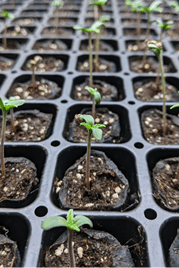
Stress Points to Avoid
The goal is to avoid any abiotic stress, be it either physiological or nutritional in nature. Examples of physiological stresses can include low or excessive light, suboptimal low or high temperatures, root binding, transplanting shock, water stress, or low or high levels of irrigation. Nutritional stresses are usually associated with deficient levels of nitrogen, phosphorus, or potassium, but could also include any other nutrient that is provided in insufficient or toxic levels. If the substrate pH is not within the recommended range of 5.8 to 6.3, growth can be slowed or stalled.
The bottom line: Anything that inhibits plant growth will have a negative impact on flower yield.

Physiological Stresses
Most physiological stresses occur when growing conditions are not optimal. As such, prevention is the key.
Transplant shock is a major stressor for autoflowering cannabis. Autoflowering types do not like to be transplanted from seedling container to the final container. The seeds can be directly sown into the final container, but there are two disadvantages: extra growing space is required during this development stage, and the production footprint can be lost if seed germination is poor. Consider using plug containers that allow the root cube to move easily from the germination tray to the final container (Fig. 2, right).

Transplanting needs to occur five to seven days after germination to avoid transplant shock (Fig. 3, left). If the seedlings are held too long and root binding occurs, the plants can stall and prematurely flower, which results in a lower yield.
Temperature shocks also can stall growth. This can be the result of growing the plants too cold or if the plants are exposed to excessively high temperatures. Keeping the plant’s activity growing within the temperature sweet spot of 68° F to 77° F (20° C to 25° C) is the key. Likewise, light quality and quantity should be optimized to maximize plant growth.
Irrigation management also is a key factor to consider when growing cannabis. Too little water will result in drought stress to the plant, causing it to stall and grow less. An overly saturated root environment can also slow plant root growth, which can lower yields.
Nutritional Stresses
Providing adequate levels of fertility keeps plants actively growing. Monitoring the substrate or fertilizer solution nutrient levels will help to ensure that you are on track. (See Cannabis Business Times’ electrical conductivity and pH articles listed in the “Learn More” sidebar at the end of this story).
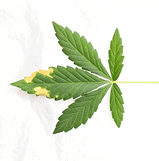

Deficient nutrient levels can cause a catastrophic failure as plants stop growing and prematurely set flower buds (Fig. 4). Excessively high levels of nutrients also slow growth and may go unnoticed unless the levels get too high and lower leaf burn (necrosis) occurs (Fig. 5, left).
Substrate or solution pH levels that are outside of the optimal range of 5.8 to 6.3 can also slow growth. Plant stall occurs most often if the substrate pH drops below 5, but may be difficult to detect visually because leaf symptoms do not develop; only smaller plants result. Substrate pH levels that are greater than 6.5 result in upper foliage leaf yellowing (interveinal chlorosis) (Fig. 6, second from left). Once pH damage is observed, flower yield already has been impacted. Again, prevention is the key.
Conclusion
Autoflowering cannabis offers the ease of production and eliminates the need to manipulate the photoperiod, making it a great option for greenhouse operators who don’t want to have to manipulate photoperiod requirements of the plant. To obtain the highest possible yield, all the plant’s growing requirements need to be met. Preventing any abiotic stressors is the key to success.
Dr. Brian E. Whipker, Ph.D, is a professor of floriculture at North Carolina State University specializing in plant nutrition, plant growth regulators and diagnostics.
Patrick Veazie is an undergraduate researcher in the Department of Horticultural Science at North Carolina State University.
David Logan is an undergrad research assistant in the Department of Horticultural Science at North Carolina State University.
Paul Cockson is a Ph.D. student at the University of Kentucky’s Horticulture department. He is a part of the controlled environment horticulture (CEH) lab and is conducting research on plant nutrition and abiotic stress impacts on greenhouse vegetable quality and fruit development.
Dr. W. Garrett Owen is an assistant professor and extension specialist of floriculture, greenhouse, and controlled-environment crop production in the Department of Horticulture at the University of Kentucky.










